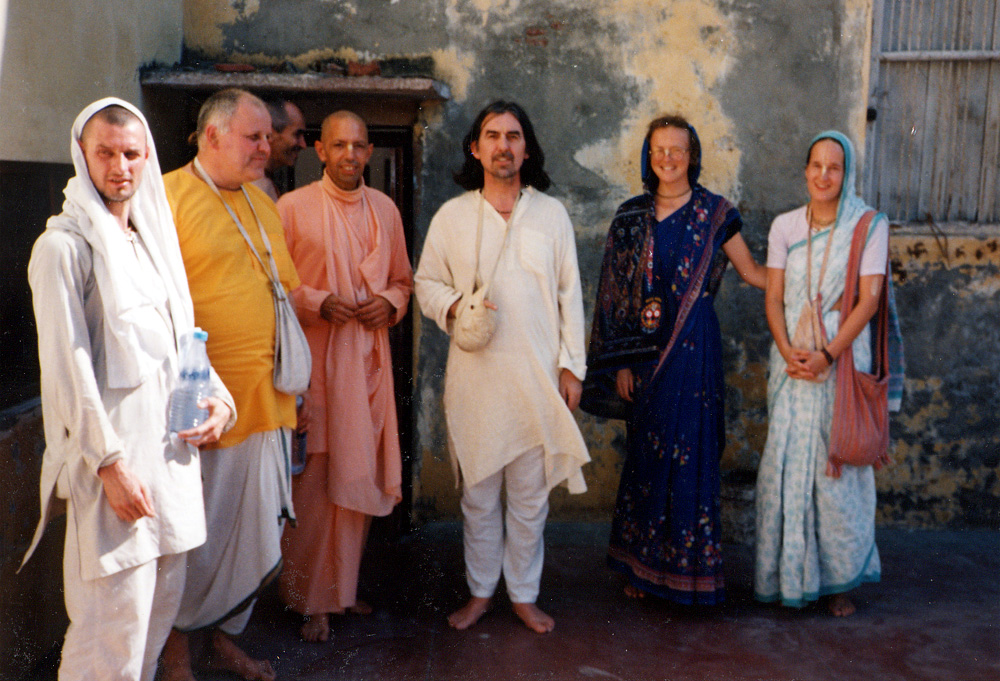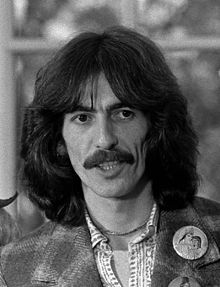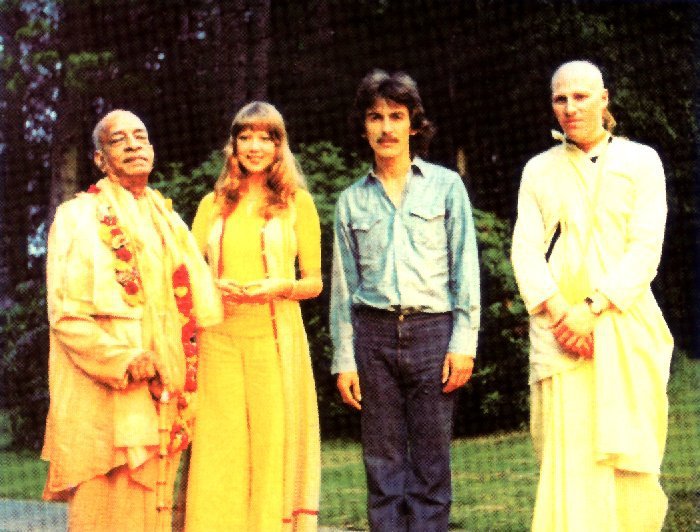George Harrison (25 Feb 1943 – 29 Nov 2001)
BIOGRAPHIES, 2 Mar 2020
Biography Online - TRANSCEND Media Service
George Harrison was a British guitarist, singer, songwriter and film producer. As a member of the Beatles, he achieved international fame and renown. During his career, he developed as a songwriter in his own right and wrote many best selling songs. In addition to music, Harrison was interested in Hindu spirituality. After meeting A.C. Bhaktivedanta Swami Prabhupada, founder of the International Society for Krishna Consciousness, of which he became an active participant, Harrison turned his devotion to Lord Krishna and became a devotee of the Hare Krishna Movement in 1969. [i]

George Harison with Hare Krishnas in Vrndavana, India, birthplace of Lord Krishna. www.harigeorgeson.com
George Harrison was born in Liverpool on 25 Feb 1943. His family were Roman Catholic and he went to school, close to Penny Lane – later to be immortalised as a Beatles song. At school, he became friendly with Paul McCartney. It was Paul McCartney who introduced George Harrison to John Lennon and George was gradually invited to play with the pre-Beatles band – The Quarryman.
“I think people who can truly live a life in music are telling the world, “You can have my love, you can have my smiles. Forget the bad parts, you don’t need them. Just take the music, the goodness, because it’s the very best, and it’s the part I give most willingly.”
– George Harrison

Most of the music recorded by the Beatles was written by McCartney or Lennon. However, towards the end of the 1960s, George became increasingly interested in songwriting, and Lennon and McCartney started to accept a couple of George’s songs on Beatles albums, such as Help and Abbey Road. His most famous songs include Here Comes the Sun and Something. However, many of his compositions were not used by the other Beatles, so this encouraged him to pursue an independent career, and was one factor in the breakup of the Beatles in 1970.
George Harrison had a great interest in Indian music and Indian spirituality. He introduced the other band members to the Hare Krishna Movement and the Maharishi Mahesh Yogi. George’s interest in Indian music and folk-rock filtered through into the later Beatles albums, helping to broaden the range of the Beatles’ music. After the split of the Beatles, he retained a keen interest in Indian spirituality and was connected with the Hare Krishna movement until his death in 2001.
After the break up of the Beatles, George Harrison pursued a successful solo career. In 1970, he released the chart-topping album All Things Must Pass, which included his own compositions and recordings with friends. This album included the iconic number one hit – My Sweet Lord.
“My idea in “My Sweet Lord,” because it sounded like a “pop song,” was to sneak up on them a bit. The point was to have the people not offended by “Hallelujah,” and by the time it gets to “Hare Krishna,” they’re already hooked, and their foot’s tapping, and they’re already singing along “Hallelujah,” to kind of lull them into a sense of false security. And then suddenly it turns into “Hare Krishna,” and they will all be singing that before they know what’s happened, and they will think, “Hey, I thought I wasn’t supposed to like Hare Krishna!”
— Interview with Mukunda Goswami, 4 Sep 1982
George Harrison also retained a variety of other interests such as gardening and working with other artists, such as Monty Python. In 1988, he co-founded the Travelling Wilburys – a super group including Roy Orbison and Bob Dylan.
In 1971 he helped organise the charity fundraiser – Concert for Bangladesh with Ravi Shankar.
George Harrison died of lung cancer on 29 Nov 2001 at the age of fifty-eight and his ashes were scattered on the Ganges in traditional Hindu fashion.
****************************
The Answer Is in the End: George Harrison, a Prophet for Our Time
By Ben Jolliffe | Resurgence Magazine – TRANSCEND Media Service
The pop star and the prophet are rare bedfellows – but with the simple wisdom of his lyrics and the melodic sweetness of his slide guitar, George Harrison brought them together in a marriage of great inspiration.
Rock ‘n’ roll’s most famous heroes tend to ensure greatness by an early death, but the “quiet Beatle” reconciled unparalleled fame with a dedicated spiritual search, crowning the lowly pop song with profound twists and joyful shouts in the process.
Unlike his fellow Beatles, Harrison’s Liverpool childhood was untouched by death, grave illness or major discord, and his early enthusiasm for music was welcomed and encouraged by his parents. His mother bought him his first guitar in 1956 when he was thirteen years old, and he would spend many hours in his bedroom with school-friend Paul McCartney, practicing.
Initially overshadowed in the Beatles by the formidable partnership of Lennon and McCartney, he began to shine in his own right with songs such as ‘If I Needed Someone’, ‘Think For Yourself’ and ‘Taxman’. Experimentation with drugs and the pressures of being one of the most famous people on Earth soon led to more serious soul-searching, and Harrison began to look to the East for inspiration.
A trip to India to study both Indian philosophy and classical music followed a meeting with Ravi Shankar in 1966.
His contribution to the Beatles became more individual as he introduced the sitar into popular music, and began the first of his metaphysical searchings in ‘Within You Without You’ on the seminal album Sgt. Pepper’s Lonely Hearts Club Band:
When you’ve seen beyond yourself
then you may find
peace of mind is waiting there.
And the time will come
when you see we’re all one
and life flows on
within you and without you.However, such insight did not save him from suffering. 1968’s ‘While My Guitar Gently Weeps’ is the heart-rending cry of one who suffers intensely at the pain of others but can do little to alleviate it, save hope and sing. Written as it became clear that the Beatles could no longer contain the dynamic that had powered them, it is the clearest expression of the conflict within Harrison between the demands of being a Beatle and an individual searching for love and meaning.
I look at you all, see the love there
that’s sleeping
while my guitar gently weeps.
I look at the floor and I see it needs
sweeping
still my guitar gently weeps.
I don’t know why nobody told you how
to unfold your love.The lyrical yearning is balanced with a melodic sweetness rarely found in pop music, and to reach such profound depths in such a limited form is surely the mark of a prophet: one who dresses timeless truths in contemporary clothes.
Following the break-up of the band in 1971, Harrison was free to follow his own path, and he fulfilled his creative potential with the huge sound and great success of his firs solo album, All Things Must Pass. Working with Eric Clapton, Rolling Stones pianist Billy Preston and old accomplice Ringo Starr, Harrison brought us the lovely pop psalm ‘My Sweet Lord’, which struck a deep chord with fans everywhere and was distinguished by hitting No. 1 in the UK charts twice; in the year after Harrison’s death as well as in 1971, the year of its release.
It was in the same year that Harrison dragooned his superstar friends to perform the first ever rock benefit concert – in aid of war-torn and drought-stricken Bangladesh. Musical collaboration, film-making, extensive charitable work, friendship and large amounts of time among his beloved plants and trees in the 1970s and 1980s continued to bear the stamp of one who sought how to love and be loved to the depths of his soul. For such a man to be the target of a knife attack, as he was in 1999, seems to be the cruelest of ironies, but his reaction – to chant the words of the Hare Krishna Maha Mantra – was characteristic.
To be a member of the world’s most famous band, yet to shine so brightly with unmistakable inner light, is to fulfill that celebrated goal of the soul-searcher in perhaps the most difficult of all surroundings.
George Harrison was unquestionably in the world yet not of it, and his final, simple words echo those who have stepped that same path before him: “Find a way to love each other.” What more need a prophet say? George Harrison died on 30th November 2001 at the age of fifty-eight.
NOTE:
[i] From the TMS Editor
_________________________
Ben Jolliffe is a freelance writer who specializes in faith, education and modern culture.
This article first appeared on Resurgence Magazine No. 220 Sep/Oct 2003.
****************************
Citation: Pettinger, Tejvan. “Biography of George Harrison”, Oxford, UK. www.biographyonline.net, 1st Jan. 2010. Last updated 1 March 2018
External links:
- George Harrison.com
- George Harrison – Life in pictures at BBC
Go to Original – biographyonline.net
Tags: Bhakti Yoga, Biography, George Harrison, Hinduism, History, ISKCON, Nonviolence, Peace, Prabhupada, Religion, Spirituality, Vedas, Vedic Culture
DISCLAIMER: The statements, views and opinions expressed in pieces republished here are solely those of the authors and do not necessarily represent those of TMS. In accordance with title 17 U.S.C. section 107, this material is distributed without profit to those who have expressed a prior interest in receiving the included information for research and educational purposes. TMS has no affiliation whatsoever with the originator of this article nor is TMS endorsed or sponsored by the originator. “GO TO ORIGINAL” links are provided as a convenience to our readers and allow for verification of authenticity. However, as originating pages are often updated by their originating host sites, the versions posted may not match the versions our readers view when clicking the “GO TO ORIGINAL” links. This site contains copyrighted material the use of which has not always been specifically authorized by the copyright owner. We are making such material available in our efforts to advance understanding of environmental, political, human rights, economic, democracy, scientific, and social justice issues, etc. We believe this constitutes a ‘fair use’ of any such copyrighted material as provided for in section 107 of the US Copyright Law. In accordance with Title 17 U.S.C. Section 107, the material on this site is distributed without profit to those who have expressed a prior interest in receiving the included information for research and educational purposes. For more information go to: http://www.law.cornell.edu/uscode/17/107.shtml. If you wish to use copyrighted material from this site for purposes of your own that go beyond ‘fair use’, you must obtain permission from the copyright owner.
